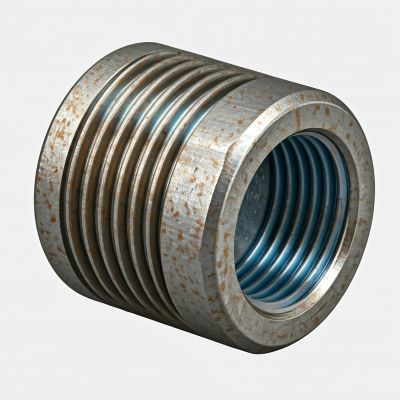From plumbing to hydraulics, thread selection is crucial for reliable systems. This guide explores the unique characteristics of BSPT threads, comparing them to other standards like NPT.
Learn how to choose the right thread for your specific needs, ensuring secure, leak-free connections and optimal system performance.
Understanding the Origins and Standards of BSPT
British Standard Pipe Taper (BSPT) threads have a rich history intertwined with the industrial revolution in Britain. They emerged as a standardized solution for connecting pipes, fittings, and components in various applications. The development of BSPT aimed to ensure compatibility and interchangeability of parts, improving efficiency and reducing manufacturing costs.
The Role of BSPT in Global Thread Standards
BSPT, while originating in Britain, has significantly influenced global thread standards. Its design principles and dimensional specifications have been adopted or adapted in many countries, contributing to a degree of international compatibility in piping systems.
What is British Standard Pipe Taper Thread
Defining BSPT and its Key Characteristics
BSPT, as the name suggests, is a tapered thread. This means the diameter of the thread gradually decreases along its length. This tapering action creates a tight seal when the male and female threads are joined, providing a secure connection.
The Difference Between BSPT and BSPP Threads
➡️ BSPT (British Standard Pipe Taper): Tapered threads that create a seal through the wedging action of the threads themselves.
➡️ BSPP (British Standard Pipe Parallel): Parallel threads that require a separate sealing element, such as an O-ring or gasket, to achieve a leak-proof connection.
Applications of BSPT in Various Industries
Plumbing and Gas Applications
BSPT is widely used in domestic and commercial plumbing systems for connecting pipes, fittings, and appliances. It is also commonly found in gas pipelines and distribution systems.
BSPT in Hydraulic Systems
In hydraulic systems, BSPT threads are employed for connecting components like valves, cylinders, and pumps. The tapered design ensures a reliable seal even under high pressures.
Use of BSPT in Oil and Gas Sectors
The oil and gas industry heavily relies on BSPT threads for connecting pipelines, valves, and other equipment involved in the extraction, transportation, and processing of oil and gas.
Benefits of Using British Standard Pipe Taper Thread
Ensuring a Secure and Leak-Free Fit
The tapered design of BSPT threads provides a self-sealing mechanism, minimizing the risk of leaks even in high-pressure applications.
Compatibility with Various Materials
BSPT threads can be used with a wide range of materials, including metals, plastics, and composites, offering versatility in design and construction.
Cost-Effectiveness in Industrial Applications
The reliable sealing and ease of assembly associated with BSPT threads contribute to cost-effectiveness in industrial applications by reducing the need for additional sealing components and minimizing downtime due to leaks.
How to Measure and Identify BSPT Threads
Tools Required for Accurate Measurement
➡️ Thread gauge: To determine the thread pitch (number of threads per inch).
➡️ Micrometer: To measure the thread diameter at different points along its length.
➡️ Caliper: To measure the overall dimensions of the threaded component.
Steps to Determine BSPT Specifications
1. Measure the thread pitch: Use a thread gauge to count the number of threads per inch.
2. Measure the thread diameter: Use a micrometer to measure the diameter at different points along the thread.
3. Determine the thread taper: Calculate the taper rate based on the diameter measurements.
4. Compare measurements to BSPT standards: Refer to the appropriate British Standard specification to confirm the thread type.
Installation and Maintenance Tips for BSPT Threads
Proper Installation Techniques for Leak Prevention
➡️ Cleanliness: Ensure the threads are clean and free of debris before assembly.
➡️ Lubrication: Apply a suitable thread sealant or lubricant to facilitate smooth assembly and improve sealing.
➡️ Hand-tightening: Initially tighten the connection by hand to avoid cross-threading.
➡️ Torque wrench: Use a torque wrench to achieve the correct tightening torque, ensuring a secure and leak-free connection.
Maintenance Practices to Extend Thread Lifespan
➡️ Regular inspection: Periodically inspect threaded connections for signs of wear, corrosion, or leaks.
➡️ Tightening checks: Re-tighten connections as needed to maintain a secure seal.
➡️ Proper lubrication: Regularly apply a suitable lubricant to prevent corrosion and ensure smooth operation.
Common Challenges and Solutions with BSPT Threads
Addressing Thread Wear and Tear
➡️ Replace worn components: Replace any components with damaged or worn threads.
➡️ Use thread repair inserts: Consider using thread repair inserts to restore damaged threads.
Solutions for Compatibility Issues
➡️ Use appropriate adapters: Use adapters to connect components with different thread types.
➡️ Ensure proper thread selection: Carefully select the correct thread type and size for the specific application.
Comparing BSPT with Other Thread Standards
BSPT vs NPT: Key Differences
➡️ Taper rate: BSPT has a slightly steeper taper than NPT (National Pipe Taper).
➡️ Thread profile: While both use a 60-degree included angle, there are subtle differences in thread profile.
➡️ Interchangeability: BSPT and NPT threads are not generally interchangeable.
Global Acceptance and Adaptation of BSPT
BSPT, while primarily a British standard, has gained global acceptance and has been adapted or adopted in various forms in many countries. This has contributed to a degree of international compatibility in piping systems.
Conclusion
BSPT threads play a crucial role in various industries, providing reliable and secure connections in plumbing, hydraulics, oil and gas, and many other sectors.
Final Tips for Choosing and Using BSPT Threads
➡️ Consult relevant standards: Always refer to the appropriate British Standard specifications when selecting and using BSPT threads.
➡️ Choose the right thread size and pitch: Select the correct thread size and pitch for the specific application to ensure a proper fit and performance.
➡️ Use proper installation and maintenance practices: Follow recommended installation and maintenance procedures to ensure long-term reliability and prevent leaks.
By understanding the characteristics, applications, and best practices associated with BSPT threads, engineers, technicians, and other professionals can effectively utilize these threads in their respective fields.
Post time: Dec-26-2024


